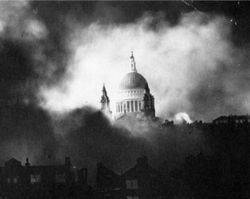|
Course Description:
Charisma is a strange,
fascinating, and ultimately puzzling phenomenon. This course will
study its expression in the charismatic leadership of Winston
Churchill and Adolf Hitler. These two men had radically opposed
ideas and values, yet they each expressed various aspects of this
complex phenomenon. Ironically, Churchill’s greatness emerged
most fully in response to Hitler’s threat to engulf the whole of
Europe as the two faced one another across the English Channel
during the fateful, destiny-shaping days of 1940-41.
We will explore several
theories of charisma, applying them to an analysis of both
Churchill and Hitler through written, video, and audio materials
and we will visit some of the many sites in or near London
associated with Churchill’s life and career. In addition, we will
extend these theories and their insights into a broader
understanding of society itself.
Why Study Charismatic
Leadership?
The concept of
charisma—literally meaning “the gift of grace”—was introduced to
the social sciences in the wri tings
of the great German scholar Max Weber early in the 1900’s. Since
that time the term has gained a wide and often misused currency in
our popular vocabulary. Part of the rationale for this course is
to correct those misunderstandings and to gain a theoretically
grounded and clear insight into the meaning of the idea.
Fortuitously, recent history has provided us with two powerful
exemplars of charismatic leadership in the persons of Winston
Churchill and Adolf Hitler. In 1940 they were locked in what
historian John Lukacs has characterized as “the eighty days duel”
in which “Churchill was the opponent of Hitler, the
incarnation of the reaction to Hitler, the incarnation of the
resistance of an old world, of old freedoms, of old standards
against a man incarnating a force that was frighteningly
efficient, brutal and new.” tings
of the great German scholar Max Weber early in the 1900’s. Since
that time the term has gained a wide and often misused currency in
our popular vocabulary. Part of the rationale for this course is
to correct those misunderstandings and to gain a theoretically
grounded and clear insight into the meaning of the idea.
Fortuitously, recent history has provided us with two powerful
exemplars of charismatic leadership in the persons of Winston
Churchill and Adolf Hitler. In 1940 they were locked in what
historian John Lukacs has characterized as “the eighty days duel”
in which “Churchill was the opponent of Hitler, the
incarnation of the reaction to Hitler, the incarnation of the
resistance of an old world, of old freedoms, of old standards
against a man incarnating a force that was frighteningly
efficient, brutal and new.”
These two figures commanded the world’s attention during what was
arguably the greatest crisis of the twentieth century. There
exist film and radio recordings of both men, as well as a huge
body of scholarly analysis exploring their lives; this provides a
rich source of primary and secondary materials through which we
can gain an understanding of charisma. In spite of all their
differences, their careers and characteristics as charismatic
figures have startling parallels. Hitler may actually have been
the more charismatic of the two, but as William Manchester has
written, “Churchill’s prospects were dramatically altered [when]
Adolf Hitler entered his life…. By provoking his titanic wrath,
this challenge from Europe released enormous stores of
long-suppressed vitality within him.” The many forms of that
vitality make Churchill a particularly compelling and attractive
study in his own right.
Churchill and Hitler both rose to power in the context of what was
to become World War Two. Comprehending their leadership requires
knowledge of the context in which their leadership emerged, and so
a secondary purpose of the course is to gain the knowledge of that
context and to see its relevance to the present day.
Objectives
of the Course:
From a strictly academic point
of view, the study of charismatic leaders is especially revealing
of a number of significant insights into the workings of
society—exploring the characteristics and behaviors of charismatic
leaders is an exciting way to learn a great deal of sociology.
From a more practical point of view, it is helpful to understand
the phenomenon of charismatic leadership in order fully to
appreciate the influence of various leaders in political and
social life today. Finally, and perhaps most important, for those
of us who are interested in becoming better leaders ourselves, the
study of charismatic leadership offers occasions rich in insight
and example of how leadership works. The course is introduces a
specific theoretical paradigm for examining and understanding
charismatic leadership, together with a more general framework for
locating the role of charismatic leadership in the creation and
maintenance of social realities. Both of these elements are
readily generalizable to other forms of leadership.
Course
materials will include excerpts from Ruth Willner, The
Spellbinders; John Lucas, The Duel; James Humes,
Churchill: Speaker of the Century; Andrew Roberts, Hitler &
Churchill: Secrets of Leadership; and Michael A. Toth,
The Theory of the Two Charismas.
This class will utilize both video and audio materials that
portray many of the dynamic elements of the charismatic leadership
of Churchill and Hitler. Lectures and discussions will accompany
these materials to provide the theoretical perspectives that help
make sense of how charismatic leadership occurs and will also
provide context and background to the actual historical events.
Additional materials portraying other leaders and incidents will
be used to provide other insights into the social dynamics of
charismatic leadership.
Students
will be expected to attend and participate in every class session,
maintain a course-long journal with responses to weekly questions,
prompts, and field trip excursions, and explore in greater depth a
self-selected topic of personal interest relevant to charismatic
leadership or a particular charismatic leader.
Basic Course Outline:
(the course will include
both weekly class sessions and outside excursions)
Week 1: Background
to understanding charismatic leadership.
Reality as a social process. The fundamental praxis of OMM.
Week 2: Expressions
of Charismatic Leadership.
Churchill, Hitler, FDR, JFK, MLK,
others.
Week 3: A useful model
for understanding charismatic/all leadership.
Vernon’s ISAS model &
its application, Martin Luther King, Jr. in Montgomery,
Alabama, parallels with Germany.
Week 4: Weber’s classic
typology: three types of leadership.
Concepts of power,
authority, legitimacy, charisma, the sacred.
Week 5: Churchill as a
charismatic leader, Hitler as a charismatic leader.
Extracting the essential characteristics.
Week 6: Hitler in his
own drama: “Seduction of a Nation,”
Weaving spells through word and image.
Week 7: Churchill in his
own words: “mobilizing the English language.”
Weaving spells through word and image.
Week 8: Are we
impervious?
Case studies and other examples.
Week 9: What happens
when charismatic leaders depart?
Routinization and crises of
succession.
Wk 10: Remaining issues:
omissions, dangers and prospects.
The
question of gender. Is charisma still possible? Still
desirable?
A Note about Class
Excursions:
London offers many fascinating sites to visit: the
Imperial War Museum (which has an excellent time-line
historical display of the war years, an extensive collection of
military weapons, and a walk-through diorama of the London Blitz),
the House of Commons
(which was the center of Churchill’s long career), the underground
Cabinet War Rooms and Churchill
Museum (from which Churchill commanded the British war effort
du ring the early 1940’s), and the
“Our Finest Hour” display of the Battle of Britain located at
the RAF Museum, just outside London proper. These latter two
provide a glimpse of the intense drama of the period of
Churchill’s compelling wartime leadership. We hope to include a
daylong excursion to
Chartwell,
Churchill’s lovely home and grounds in Kent, kept largely just the
way he lived in it and which now also serves as a museum with a
large collection of his art. Reactions to and reflections on these
excursions will be part of students’ journaling activities. ring the early 1940’s), and the
“Our Finest Hour” display of the Battle of Britain located at
the RAF Museum, just outside London proper. These latter two
provide a glimpse of the intense drama of the period of
Churchill’s compelling wartime leadership. We hope to include a
daylong excursion to
Chartwell,
Churchill’s lovely home and grounds in Kent, kept largely just the
way he lived in it and which now also serves as a museum with a
large collection of his art. Reactions to and reflections on these
excursions will be part of students’ journaling activities.
Some
Recommended Advance Surfing:
|




 tings
of the great German scholar Max Weber early in the 1900’s. Since
that time the term has gained a wide and often misused currency in
our popular vocabulary. Part of the rationale for this course is
to correct those misunderstandings and to gain a theoretically
grounded and clear insight into the meaning of the idea.
Fortuitously, recent history has provided us with two powerful
exemplars of charismatic leadership in the persons of Winston
Churchill and Adolf Hitler. In 1940 they were locked in what
historian John Lukacs has characterized as “the eighty days duel”
in which “Churchill was the opponent of Hitler, the
incarnation of the reaction to Hitler, the incarnation of the
resistance of an old world, of old freedoms, of old standards
against a man incarnating a force that was frighteningly
efficient, brutal and new.”
tings
of the great German scholar Max Weber early in the 1900’s. Since
that time the term has gained a wide and often misused currency in
our popular vocabulary. Part of the rationale for this course is
to correct those misunderstandings and to gain a theoretically
grounded and clear insight into the meaning of the idea.
Fortuitously, recent history has provided us with two powerful
exemplars of charismatic leadership in the persons of Winston
Churchill and Adolf Hitler. In 1940 they were locked in what
historian John Lukacs has characterized as “the eighty days duel”
in which “Churchill was the opponent of Hitler, the
incarnation of the reaction to Hitler, the incarnation of the
resistance of an old world, of old freedoms, of old standards
against a man incarnating a force that was frighteningly
efficient, brutal and new.” ring the early 1940’s), and the
ring the early 1940’s), and the